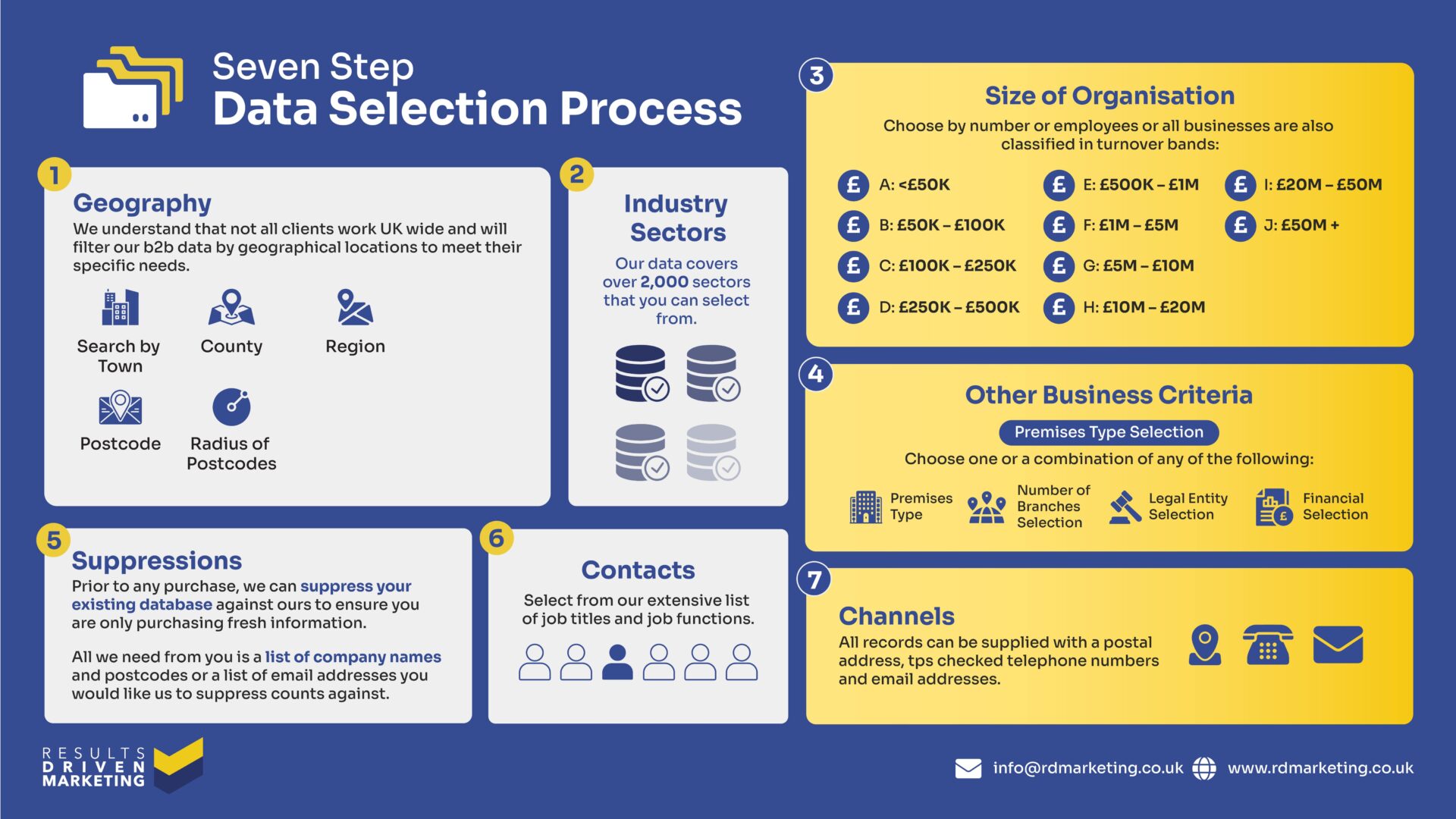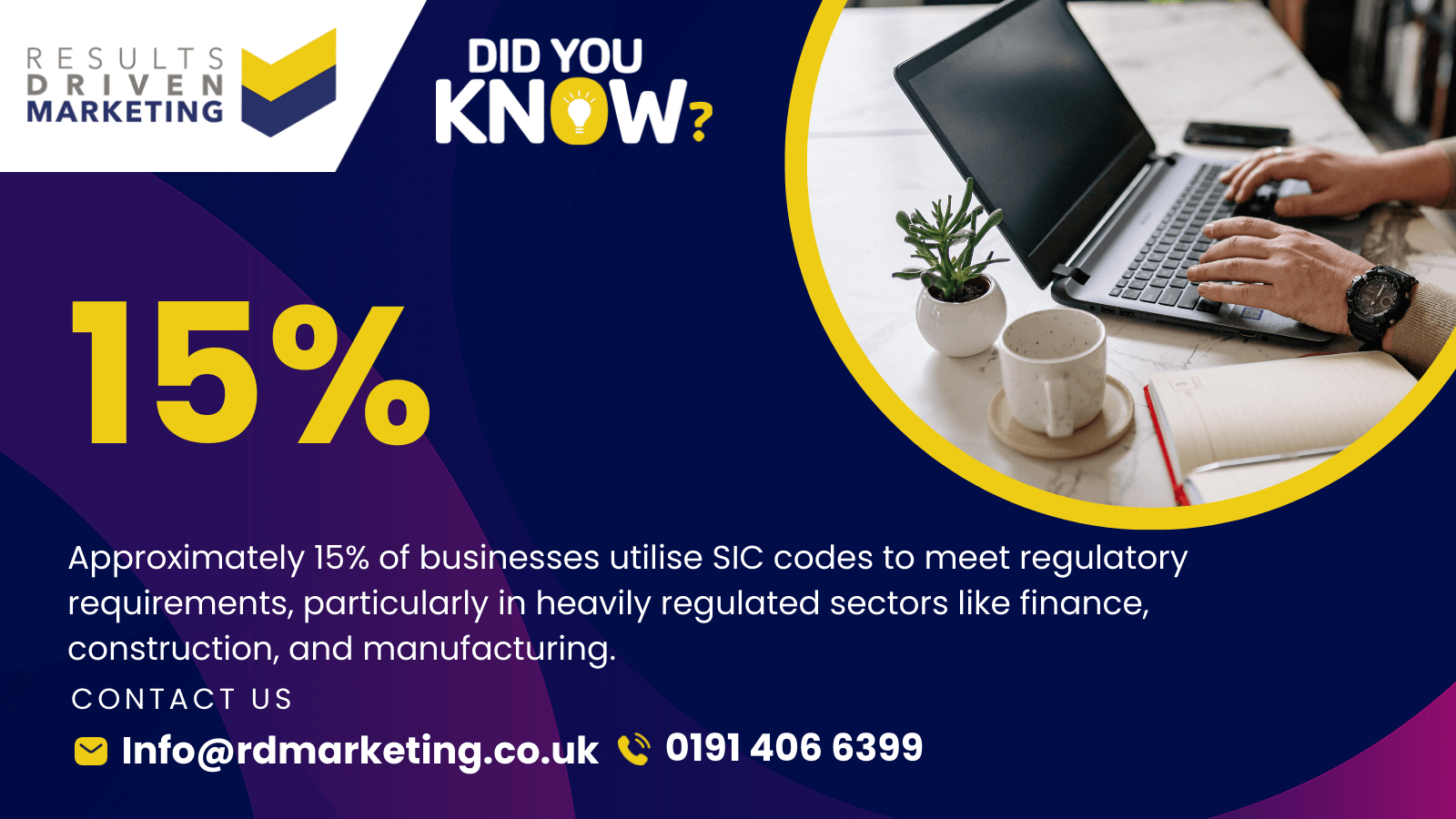
What is an SIC Code?
If you’ve ever worked with business data or explored the SIC Classification List to organise companies by industry, you’ve probably come across the term SIC code. But what exactly does it mean, and why is it so important?
In simple terms, an SIC code—short for Standard Industrial Classification code—is a four-digit number that categorises businesses based on their main economic activities. This system has been around for decades, making it easier to group companies into specific industries.
For marketers, data analysts, and business owners, SIC codes from a SIC Classification List are a game-changer when it comes to understanding market segments and targeting the right sectors effectively.
Now, let’s talk about the SIC Classification List. This comprehensive index organises SIC codes from a SIC Classification List into a structured format, providing businesses with an accessible tool for identifying industries and aligning their strategies. Whether you’re refining your B2B data or tailoring your email marketing campaigns, the SIC Classification List is essential for segmenting data accurately and targeting the right audience.
At RD Marketing, we understand the significance of precise industry classification. That’s why our services, like B2B Data and Direct Mail Data, are designed to help businesses leverage data effectively and connect with their ideal clients.
Why does this matter to your business?
- It ensures your marketing campaigns reach the right industries.
- It improves data accuracy and segmentation for better ROI.
- It supports compliance efforts by categorising businesses correctly.
With tools like the SIC Classification List, businesses can stay ahead in their marketing efforts and make informed decisions. As you read on, we’ll dive deeper into how SIC codes from a SIC Classification List work and why they’re critical for any data-driven strategy.
Table of contents:
What is an SIC Code from a SIC Classification List?
At its core, an SIC code—short for Standard Industrial Classification code—is a unique numerical identifier assigned to businesses based on their primary industry or economic activity. Essentially, it’s a way to group similar businesses into categories, making it easier for organisations to classify and analyse data across industries.
SIC codes are structured in a hierarchical format:
- First two digits: Indicate the major industry group.
- Third digit: Breaks the group into specific industry divisions.
- Fourth digit: Pinpoints the exact activity or niche of a business.
For example, a company manufacturing computers might have a different SIC code than one assembling office furniture, even though both are part of the broader manufacturing sector. By consulting a detailed SIC classification list, you can identify the exact SIC code that applies to any business.
Why Are SIC Codes from the SIC Classification List Important in Business and Data Management?
SIC codes are far more than just numbers. They’re an indispensable tool for businesses, marketers, and even government agencies. Here’s why they matter:
Streamlined Market Segmentation
SIC codes allow you to focus on specific industries or niches, helping you identify and target the right audience. For instance, if you’re planning a direct mail campaign, having access to precise direct mail data can ensure your message reaches the right businesses. Tools like RD Marketing’s Direct Mail Data make this process seamless.
Data-Driven Marketing Strategies
By using an SIC classification list, marketers can tailor their outreach efforts to align with specific industries. Whether you’re utilising email address list data or telemarketing data, SIC codes provide the foundation for building highly targeted campaigns. RD Marketing offers Telemarketing Data and Email Address List Data to help you achieve better results.
Regulatory Compliance
In some regions, businesses are required to report their SIC codes for compliance and regulatory purposes. Whether it’s filing reports with local authorities or adhering to data protection laws, SIC codes from a SIC Classification List play a critical role in keeping businesses compliant.
Enhanced B2B Data Analysis
SIC codes are key to understanding trends and patterns within industries. For instance, if you’re analysing B2B data, grouping businesses by their SIC codes can uncover actionable insights, like which industries are growing and which are facing challenges. RD Marketing’s B2B Data Services provide the perfect starting point for exploring such trends.
History and Overview of SIC Codes from the SIC Classification List
The Origin of SIC Codes
To understand the significance of SIC codes, let’s start with their history. The concept of the Standard Industrial Classification (SIC) system was introduced in the United States during the 1930s.
At that time, businesses were growing rapidly, and the need for a standardised way to classify industries became essential. Governments, economists, and statisticians recognised that having a universal framework would make it easier to study economic activity and make informed decisions.
The SIC system was designed to group similar businesses into categories based on their primary activities. This organisation allowed for streamlined economic analysis, simplified government reporting, and better resource allocation. Over time, the system expanded and became a critical tool for both private and public sectors.
Whether you’re working with B2B data or looking to optimise email marketing management services, knowing the SIC code of a business is an essential first step. RD Marketing’s B2B Data Services ensure you have the right tools to segment and target businesses effectively.
The Purpose of the SIC Classification System
The primary goal of the SIC classification list is to simplify the organisation of businesses into categories based on their primary industry. This structure offers several benefits:
- Consistency Across Industries: With SIC codes, businesses can be categorised in a uniform manner, which is crucial for analysing trends and making comparisons.
- Improved Data Analysis: By grouping businesses into specific categories, analysts can identify trends, track economic shifts, and predict market behavior. For example, if you’re running a campaign using Telemarketing Data, targeting the right SIC code ensures higher conversion rates.
- Government and Regulatory Use: SIC codes have been used for everything from tax reporting to regulatory compliance. Governments rely on these codes to gather accurate data about industries and allocate resources appropriately.
For businesses, the ability to segment their audience using an SIC classification list is invaluable. Whether you’re building a mailing list or refining your direct mail data, SIC codes are the backbone of effective marketing strategies.
The Transition from SIC to NAICS
While the SIC system served industries well for decades, the introduction of new technologies and changes in the global economy necessitated an update. In 1997, the U.S., Canada, and Mexico adopted the North American Industry Classification System (NAICS) as a replacement for SIC codes. NAICS was designed to better reflect modern industries and cross-border trade in North America.
So, what’s the difference between the two?
- SIC Codes: Focused on grouping businesses by their primary activity, often emphasising traditional industries.
- NAICS Codes: Provide a more detailed and modernised framework, accommodating emerging industries like technology and e-commerce.
Although NAICS is now widely used in North America, SIC codes are still relevant. In fact, many businesses and organisations continue to rely on the SIC classification list for its simplicity and widespread recognition.
If you’re dealing with international markets, like building a campaign using International Email Lists, SIC codes remain a useful tool. They offer a consistent way to classify industries, regardless of location.
Why Businesses Still Rely on SIC Codes
Despite the adoption of NAICS in some regions, SIC codes are still integral to many business processes:
- Many datasets, including consumer data and email address list data, still rely on SIC codes for classification.
- They provide an easier way to cross-reference older data with newer systems, ensuring continuity in analysis.
- SIC codes are still used in global markets where NAICS has not been adopted, making them vital for international campaigns.
For instance, if your company needs data enrichment services to refine existing records or ensure accuracy, understanding SIC codes can enhance the process. RD Marketing’s Data Enrichment Services are designed to ensure that your business operates with the highest quality data.
Structure of SIC Codes
To really grasp the power and utility of SIC codes, it’s essential to understand their structure. The SIC classification list organises businesses into a logical, hierarchical format. This structure not only categorises industries in a meaningful way but also allows for detailed analysis of businesses based on their primary activities.
How the SIC Hierarchical Structure Works
The SIC system is built on a four-digit numerical hierarchy, which classifies industries from broad categories to very specific activities. Here’s a breakdown:
Divisions
The highest level of classification, grouping industries into broad sectors such as Manufacturing, Retail, or Services.
Example divisions include “Agriculture, Forestry, and Fishing” or “Transportation and Public Utilities.”
Major Groups
Each division is divided into major groups that narrow down the category further.
For example, within the “Manufacturing” division, there might be major groups for “Machinery” or “Food Products.”
Industry Groups
Major groups are then split into industry groups that define specific types of businesses within the category.
For instance, “Food Products” could include industry groups for “Dairy Products” or “Bakery Goods.”
Specific Industries (4-Digit Codes)
-
- The most detailed level, the four-digit SIC code, identifies a specific industry or niche.
- For example, within “Dairy Products,” a four-digit SIC code might represent “Butter Manufacturing.”
By following this system, the SIC classification list provides an incredibly detailed and practical way to group businesses.
A Typical SIC Code Breakdown
Let’s look at an example to illustrate how the hierarchy works in action:
- Division: Manufacturing (20–39)
- Major Group: Food Products (20)
- Industry Group: Dairy Products (202)
- Specific Industry (SIC Code): Butter Manufacturing (2021)
This system ensures that every business is categorised based on its primary activity, making it easier to search for and analyse industry-specific information. Whether you’re working with direct mail data or developing email marketing management services, understanding these classifications ensures that your targeting is spot on. Explore RD Marketing’s Direct Mail Data Services for more insights into reaching the right audience.
Why This Hierarchical Structure Matters
The structured approach of SIC codes offers several advantages:
- Precision Targeting: Businesses can identify their exact audience using the SIC classification list. This is especially useful for campaigns involving Telemarketing Data or International Email Lists.
- Streamlined Data Management: Classifying data using SIC codes ensures accuracy and consistency, which is vital for data cleansing services. RD Marketing’s Data Cleansing Services can help keep your records organised and up to date.
- Actionable Insights: Grouping businesses into categories reveals industry-specific trends, allowing marketers to make data-driven decisions.
How You Can Use SIC Codes for Better Business Outcomes
Refine Your Audience: Use SIC codes to segment your audience by industry, enabling more effective targeting in your campaigns. RD Marketing’s Email Address List Data ensures that you’re always connecting with the right businesses.
Improve Campaign Accuracy: With tools like CTPS Checker services, you can enhance compliance while maintaining precise targeting.
Enrich Your Existing Data: If your data lacks industry-specific details, RD Marketing’s Data Enrichment Services can fill in the gaps using the SIC classification list.
Applications of SIC Codes
The SIC classification list isn’t just a tool for organising businesses; it’s a dynamic resource used across industries for a variety of critical applications. Whether you’re segmenting your market, ensuring regulatory compliance, or crafting targeted marketing campaigns, SIC codes play a central role. Here’s how businesses and organisations leverage this classification system for success.
Business Segmentation and Market Research
SIC codes are incredibly valuable when it comes to identifying and understanding specific market segments. By grouping businesses based on their primary activities, the SIC classification list provides a foundation for in-depth market research.
- Segmenting by Industry: SIC codes allow businesses to categorise their audience into distinct industry groups, enabling more precise targeting.
- Analysing Trends: Researchers and analysts use SIC codes to study market trends and identify growth opportunities within specific sectors.
- Refining Strategies: By focusing on the industries most relevant to their goals, businesses can allocate resources more effectively.
For example, if you’re planning a campaign targeting specific industries, RD Marketing’s Direct Mail Data ensures your message reaches the right decision-makers.
Government Regulation and Compliance
Government agencies rely on SIC codes to maintain consistent reporting and regulation across industries. From tax filings to economic analyses, these codes ensure that businesses are classified accurately.
- Regulatory Filings: Businesses often need to report their SIC codes for compliance with local, national, or international regulations.
- Economic Analysis: Governments use SIC codes to monitor industry-specific growth, employment, and productivity.
- Targeted Programs: Public agencies can design initiatives tailored to specific industries based on the SIC system.
For businesses navigating regulatory requirements, RD Marketing’s CTPS Checker ensures compliance while maintaining high-quality data for marketing campaigns.
Marketing and Sales Strategies
When it comes to crafting effective marketing and sales strategies, SIC codes are a game-changer. They help businesses pinpoint their audience, refine messaging, and boost ROI.
- Personalised Campaigns: By using the SIC classification list, marketers can create tailored messages that resonate with specific industries.
- Efficient Outreach: Whether through telemarketing data or email address list data, SIC codes streamline the process of reaching the right contacts. RD Marketing’s Telemarketing Data and Email Address List Data are excellent resources for this purpose.
- Strategic Partnerships: Sales teams can use SIC codes to identify potential partners or clients in complementary industries.
With tools like RD Marketing’s Email Marketing Management Services, businesses can further optimise their campaigns for maximum engagement.
B2B Data Acquisition
In the realm of B2B marketing, having accurate and detailed data is non-negotiable. SIC codes are a key factor in acquiring high-quality data that drives results.
- Targeted Mailing Lists: By selecting industries based on their SIC codes, businesses can build highly targeted mailing lists. RD Marketing offers B2B Data tailored to your needs.
- Enhancing Data Accuracy: The SIC classification list helps businesses verify and update their existing data, ensuring precision in outreach. RD Marketing’s Data Cleansing Services are perfect for this.
- Global Campaigns: For companies looking to expand internationally, SIC codes simplify the process of targeting industries in different regions. RD Marketing’s International Email List is an excellent starting point.
Why SIC Codes Are Indispensable
From segmentation to compliance, the SIC classification list remains a cornerstone for businesses looking to grow. Whether you’re analysing consumer data for trends or enriching your records with RD Marketing’s Data Enrichment Services, SIC codes provide the clarity and structure you need.
The next time you’re planning a marketing campaign, building a mailing list, or diving into market research, remember the power of SIC codes. And for all your data needs, visit www.rdmarketing.co.uk to discover how our solutions can help you succeed.
Differences Between SIC and NAICS Codes
If you’re diving into industry classification systems, chances are you’ve come across both SIC and NAICS codes. While both serve a similar purpose—organising businesses based on their primary activities—their structure and applications differ significantly. Let’s explore what makes the NAICS system unique, how it compares to the SIC classification system, and why the SIC classification list remains highly relevant.
Overview of the Newer NAICS System
The North American Industry Classification System (NAICS) was introduced in 1997 to replace the SIC system in the United States, Canada, and Mexico. Unlike SIC codes, which focus on a business’s primary activity, NAICS was designed to better capture the complexities of modern industries. Here’s a quick breakdown of what makes NAICS unique:
- Regional Standardisation: NAICS was developed collaboratively by the U.S., Canada, and Mexico to ensure consistency in cross-border trade and economic reporting.
- Detailed Hierarchies: NAICS offers up to six digits for classification, allowing for more specific categorisation compared to the four-digit SIC codes.
- Inclusion of Emerging Industries: NAICS accommodates newer industries like technology, software, and e-commerce, reflecting the evolving economic landscape.
For businesses engaging in international campaigns, NAICS codes are particularly valuable. However, SIC codes remain a vital tool, especially for global data management. RD Marketing’s International Email List is built to leverage both systems effectively.
Key Differences Between SIC and NAICS
While both systems share the goal of classifying industries, their approach and focus differ in key ways:
Depth of Classification
SIC Codes: Use a four-digit format to group businesses, focusing on their primary activity.
NAICS Codes: Offer up to six digits, providing a more granular view of industry activities.
Industry Representation
SIC Codes: Emphasise traditional industries like manufacturing and agriculture.
NAICS Codes: Expand to include modern sectors like information technology, renewable energy, and online services.
Applicability
SIC Codes: Remain widely used in legacy systems, global markets, and by businesses managing historical data.
NAICS Codes: Predominantly used in North America for newer datasets and government reporting.
If you’re targeting businesses across industries with tools like direct mail data or telemarketing data, it’s crucial to understand both systems. RD Marketing’s Telemarketing Data ensures that your outreach remains relevant, whether you rely on SIC or NAICS classifications.
Why SIC Codes Are Still Relevant
Even with the widespread adoption of NAICS, the SIC classification list continues to hold significant value for several reasons:
- Global Recognition: SIC codes are still recognised internationally, making them indispensable for cross-border campaigns and research.
- Legacy Systems: Many databases, including RD Marketing’s B2B data, still utilise SIC codes for consistency and ease of use.
- Simplified Categorisation: For many businesses, the four-digit SIC code provides a straightforward way to classify industries without the complexity of six-digit NAICS codes.
For businesses looking to enhance their data accuracy, tools like RD Marketing’s Data Cleansing Services can ensure your SIC-coded records are up-to-date and reliable.
How to Leverage SIC and NAICS Together
Using SIC and NAICS codes in tandem can offer the best of both worlds. For example:
- Use SIC codes for global campaigns or historical data analysis.
- Rely on NAICS for deeper insights into modern industries or North American markets.
- Cross-reference both systems to enrich your data and improve segmentation.
With RD Marketing’s Data Enrichment Services, you can integrate both systems into your datasets, ensuring comprehensive industry coverage.
Advantages and Limitations of SIC Codes
SIC codes have been a cornerstone of industry classification for decades. While they offer many benefits for businesses, they’re not without their challenges. Understanding both the strengths and limitations of the SIC classification list is crucial for anyone using this system in modern business applications. Let’s dive into the advantages and drawbacks to give you a clearer picture.
Benefits of Using SIC Codes in Modern Businesses
Despite being introduced nearly a century ago, SIC codes remain incredibly useful for businesses today. Here are some of the key benefits they offer:
Simplicity and Consistency
The straightforward four-digit format of SIC codes makes them easy to use, even for those new to industry classification.
This simplicity ensures consistency across legacy systems, making data management more reliable.
Global Relevance
The SIC classification list is still recognised internationally, making it an essential tool for businesses operating across borders.
For example, when building a global marketing strategy, you can rely on RD Marketing’s International Email List to reach specific industries worldwide.
Targeted Marketing Opportunities
SIC codes allow businesses to focus their marketing efforts on specific industries, improving ROI.
Whether you’re using telemarketing data or email address list data, SIC codes help ensure your campaigns reach the right audience. RD Marketing’s Telemarketing Data is an excellent resource for industry-specific targeting.
Historical Data Analysis
Many datasets, including economic reports and industry trends, still rely on SIC codes.
This consistency allows businesses to analyse historical data and compare it with current trends.
Compliance and Reporting
Many regulatory bodies and government agencies still require SIC codes for filings and compliance purposes.
Tools like RD Marketing’s CTPS Checker help businesses ensure compliance while maintaining the accuracy of their SIC-based data.
Versatile Applications
From building a mailing list with direct mail data to enriching your existing records with industry-specific details, SIC codes have countless practical applications. RD Marketing’s Data Enrichment Services can add even more value to your datasets.
Challenges and Drawbacks of the SIC System
While SIC codes are undeniably useful, they’re not without their limitations. Here are some challenges businesses may encounter when using the SIC classification list:
Limited Industry Coverage
The SIC system primarily focuses on traditional industries like manufacturing and agriculture.
Emerging sectors like renewable energy, e-commerce, and technology aren’t adequately represented, making it harder to classify modern businesses.
Lack of Granularity
The four-digit structure of SIC codes doesn’t always provide enough detail for businesses seeking highly specific classifications.
For deeper insights into niche industries, NAICS codes or enriched datasets may be more appropriate. RD Marketing’s Data Cleansing Services can help refine your SIC-based records to improve accuracy.
Geographical Limitations
While SIC codes are widely recognised, they’re not universally used. Some regions and industries have shifted to alternative systems like NAICS.
Businesses targeting North America might need to incorporate NAICS codes alongside SIC codes to cover all bases.
Outdated Structure
The SIC system hasn’t been updated to reflect the complexities of modern industries.
This can lead to misclassifications or difficulties in segmenting businesses accurately. For example, companies in hybrid or multi-faceted industries might not fit neatly into the SIC framework.
Dependency on Legacy Systems
Many organisations rely on SIC codes because they’re embedded in older systems, which can limit flexibility.
Transitioning to newer systems or integrating with modern classification methods can be challenging without tools like RD Marketing’s B2B Data, which support both SIC and NAICS classifications.
Balancing the Pros and Cons
While SIC codes aren’t perfect, they’re still an incredibly valuable tool for businesses, especially when combined with modern data solutions. To get the most out of the SIC classification list, consider the following strategies:
- Enhance Your Data: Use services like RD Marketing’s Data Enrichment Services to fill in gaps and add depth to your SIC-coded records.
- Expand Your Reach: For businesses operating globally, rely on tools like International Email Lists to target industries across regions.
- Stay Compliant: Use solutions like the CTPS Checker to ensure your data complies with industry regulations.
Frequently Asked Questions About SIC Codes
SIC codes can be a bit complex, especially if you’re new to the SIC classification list. To clear up any confusion, we’ve compiled answers to some of the most frequently asked questions about SIC codes. Let’s dive in!
What Industries Use SIC Codes?
The beauty of the SIC system lies in its wide applicability across virtually every industry. From traditional sectors like manufacturing and agriculture to service-oriented fields like retail and finance, the SIC classification list covers a vast array of business types. Here are some examples:
- Manufacturing: Used for classifying businesses that produce goods, such as machinery, food products, or textiles.
- Retail and Wholesale Trade: Helps organise businesses based on the types of products they sell or distribute.
- Services: Encompasses industries like hospitality, healthcare, and professional services.
- Construction and Real Estate: Covers companies involved in building, development, or real estate management.
For businesses operating in niche markets or targeting specific industries, SIC codes are an indispensable tool. Whether you’re using B2B data or building a campaign with direct mail data, SIC codes ensure you’re always targeting the right audience. RD Marketing’s B2B Data Services provide tailored solutions for businesses in any industry.
Are SIC Codes Still Relevant Today?
Absolutely! While NAICS codes have gained prominence in North America, SIC codes remain highly relevant for several reasons:
Global Recognition: SIC codes are still widely used in international markets, making them essential for global campaigns.
Legacy Systems: Many businesses and government agencies rely on SIC-coded data, particularly for historical analysis.
Ease of Use: The simpler, four-digit structure of SIC codes is often more accessible than the more detailed NAICS system.
Marketing Precision: Tools like RD Marketing’s Telemarketing Data and Email Address List Data are built on SIC classifications, ensuring campaigns are both accurate and impactful.
If you’re running campaigns or managing datasets, having access to the SIC classification list is still critical. For businesses looking to optimise their data, RD Marketing’s Data Cleansing Services can help update and refine your SIC-coded information.
How Do I Update or Correct My Business’s SIC Code?
Keeping your business’s SIC code accurate is essential for compliance, market analysis, and targeted marketing. Here’s a simple step-by-step guide to updating or correcting your SIC code:
Verify Your Current SIC Code:
Look up your business’s existing SIC code using resources like government databases or industry directories.
Cross-check it with the SIC classification list to ensure it reflects your primary activity.
Identify the Correct Code:
If your business has expanded or shifted focus, find the most appropriate SIC code for your current operations.
RD Marketing’s Data Enrichment Services can assist in identifying the correct code for your industry.
Submit Updates:
For regulatory purposes, contact the relevant government agency to update your SIC code.
If you’re using the code for marketing or segmentation, ensure it’s updated across your databases.
Maintain Data Accuracy:
-
- Regularly review and update your SIC code as your business evolves.
- Use tools like RD Marketing’s CTPS Checker to ensure your data remains compliant and up-to-date.
By keeping your SIC code accurate, you’ll not only enhance your marketing campaigns but also ensure compliance with industry regulations. For businesses looking to go a step further, RD Marketing’s International Email List is a great way to leverage accurate SIC-coded data for global outreach.
Conclusion
SIC codes have stood the test of time, providing businesses with a reliable and straightforward way to classify industries and unlock valuable insights. Whether you’re a marketer trying to fine-tune a campaign, a business owner seeking to understand your industry better, or a data analyst diving into trends, the SIC classification list is a tool you can’t afford to overlook.
Recap of Key Points
Here’s a quick summary of what we’ve covered:
- What is an SIC Code? These four-digit codes categorise businesses based on their primary activities, making industry classification clear and consistent.
- Structure of SIC Codes: From broad divisions to specific industries, the hierarchical system allows for both general and detailed analysis.
- Applications of SIC Codes: Essential for business segmentation, government compliance, targeted marketing, and B2B data acquisition.
- Differences Between SIC and NAICS: While NAICS offers more detail, the simplicity and global recognition of SIC codes keep them relevant.
- Advantages and Limitations: SIC codes are globally recognised, simple, and consistent but lack granularity in modern industries.
- Frequently Asked Questions: From their relevance today to updating your SIC code, we’ve tackled the most common queries.
SIC codes remain a powerful tool in the world of business and marketing. Paired with modern data solutions, they can help you gain a competitive edge, reach the right audience, and grow your business with precision.
Take Action: Explore Data-Driven Solutions
Now that you understand the importance of SIC codes, it’s time to put that knowledge into action. Whether you’re running targeted campaigns, updating your datasets, or exploring new markets, RD Marketing has the tools and expertise to help.
- Need industry-specific insights? Check out our B2B Data services for customised solutions.
- Want to refine your audience? Our Direct Mail Data and Telemarketing Data services can help you target with precision.
- Expanding internationally? Leverage our International Email List to connect with businesses worldwide.
- Keeping your data clean and compliant? Use our Data Cleansing Services and CTPS Checker for reliable results.
At RD Marketing, we specialise in data-driven solutions tailored to your business needs. Visit www.rdmarketing.co.uk to explore how we can support your marketing and growth strategies with tools like Email Marketing Management Services and Data Enrichment Services.
Who are we?
Thinking about “how do I buy data“?
Providing b2b database solutions is our passion.
Offering a consultancy service prior to purchase, our advisors always aim to supply a database that meets your specific marketing needs, exactly.
We also supply email marketing solutions with our email marketing platform and email automation software.
Results Driven Marketing have the best data of email lists for your networking solutions as well as direct mailing lists & telemarketing data in telemarketing lists
We provide data cleansing and data enrichment services to make sure you get the best data quality.
We provide email marketing lists and an international email list for your business needs.
At RDM We provide b2c data as we have connections with the best b2c data brokers.
A good quality b2b database is the heartbeat of any direct marketing campaign…
It makes sense to ensure you have access to the best!
Call us today on 0191 406 6399 to discuss your specific needs.
Results Driven Marketing
0191 406 6399









